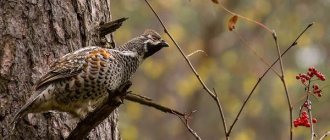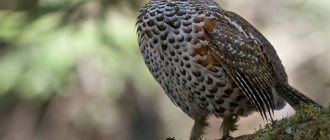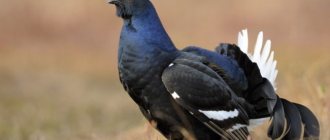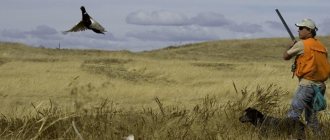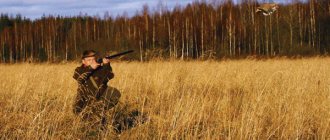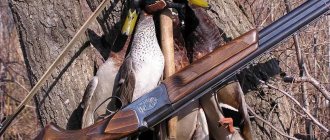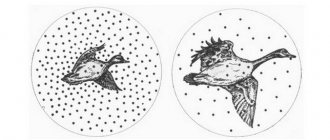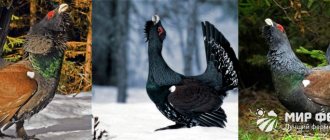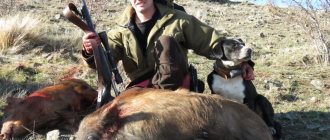One of the most popular types of game is hazel grouse. Despite the small weight of the bird, only about 500 grams, fishermen actively harvest this trophy, regardless of the season. In summer, it is customary to shoot hazel grouse from the approach, but in winter, hunting tactics will be somewhat different.
In this article we will look at what features of bird behavior in winter should be taken into account when going hunting, and we will also pay attention to the selection of weapons and the choice of acceptable tactics for catching this game.
Bird habits and habitats
A successful hunt for hazel grouse is impossible without a good knowledge of the habits of this forest bird, the peculiarities of its behavior at different times of the year, and its favorite habitats. The hazel grouse is one of the smallest species of grouse: the average weight of an adult bird is 0.5 kg. Leads a sedentary life, wintering in its permanent habitat. Thanks to this, this bird is available for fishing all year round.
The hazel grouse settles in dense forests, preferring forests of coniferous trees: pine, spruce, and cedar forests. It nests not on tree branches, but directly on the ground, among the rubble of windbreaks or in dense bushes. It especially loves thickets formed on the site of old cutting areas or fire pits. Sometimes it can build nests in the hollows of old trees. In central Russia it is often found in mixed forests, especially with the presence of spruce and alder. Hazel grouse feed on seeds of spruce cones and alder catkins in autumn and winter. In purely deciduous forests - oak forests, birch forests, aspen forests - the bird is much less common than in coniferous forests.
Another condition necessary for the habitat of hazel grouse is the presence of a reservoir in the immediate vicinity. It could be a lake, river, stream, swamp. During the ripening of wild berries, birds move to berry areas. The rest of the time it lives mainly in the same area, not moving more than 0.5–1 km from the nesting sites.
It moves mostly on foot, picking up seeds from the forest floor and pecking berries. It takes off only when necessary, and moves low to the ground, while deftly maneuvering between tree trunks and bushes. The hazel grouse is a very cautious bird, and at the first suspicion of danger it moves away or hides. Activity begins after sunrise, no earlier than 9–10 am. These birds are found in pairs, and both sexes are similar in plumage color, so it is possible to distinguish a male from a female only upon closer examination.
Differences at different times of the year
Hazel grouse breed in the summer. Therefore, often at the end of summer or early autumn you can meet a whole family with a brood. For experienced hunters, shooting at a brood on the ground is considered unsportsmanlike behavior - it is better to wait for it to fly away and take one or two trophies. In the spring and most of the summer, hunting is prohibited to give the birds the opportunity to raise their chicks. In most Russian regions, the period of permitted fishing is from the end of August to February inclusive. But in some areas the season ends with the onset of the new year. The main hunting season comes in autumn and winter. At these times of the year, the behavior of hazel grouse is different, and therefore winter and autumn hunting have their own nuances and differences.
Features of winter hunting
For successful winter hunting, it is recommended to notice the permanent habitats of game birds in the summer or autumn. In winter, hazel grouse are less active and spend most of the day under the snow, in holes. In the cold they get out only to eat, flying up onto tree branches. Therefore, the “hole” hunting method is most often used in winter. Some hunters also use decoys in winter, but to do this you must imitate the bird's voice very accurately. At this time, she becomes much more careful than during the lekking period, and it is more difficult to lure her.
Autumn hunt
In August-September, young birds still live as a brood, gaining experience under the supervision of their parents. The beginning of autumn is the only time when it is possible to go out with a dog to see hazel grouse. Later, when the young birds scatter and create pairs, this method of hunting will be almost impossible. Autumn is the time for blueberries, lingonberries, sea buckthorn, and rowan to ripen in the forest. At such times, the bird is most easily found in berry fields, where it is found in fairly large flocks, sometimes literally littering the bushes.
By October, after molting, the time for mating and the creation of new pairs begins. After wintering together, such couples breed new offspring in the spring. This time is the best time for hunting with a decoy or a surge. Thus, a feature of the autumn season is hunting:
- with a dog;
- with semolina;
- surge
Hole hunting
If you are already familiar with the habitats of hazel grouse in the hunting area, then it’s a small matter. You will need to find the holes in which the game is hiding. Look for them in the thickets by small depressions in the snow and paw prints - often, when going out to feed, they take several steps before taking off.
If there are a lot of tracks near the hole and there are other holes, then it is most likely empty. After finding the holes, you can try to set traps or continue the hunt by luring with a peep.
The best time for hunting is when the birds come out to feed. They will quickly respond to the sound of a decoy, which you must have with you.
This is interesting: Paracord Monkey Fist: interesting applications and complete instructions
Choosing weapons and ammunition
The most commonly used hunting weapon for hazel grouse is the smoothbore shotgun. You can use 16-32 or 410 gauge. It is best to choose guns with a small distribution of shot. An overly dense sheaf of warhead, with a successful hit, will literally fill a small carcass with metal. The most suitable shot size is No. 6–8. In some cases, for example, when hunting with a decoy, the bird approaches the hidden hunter at a short distance, not exceeding 5–10 meters. For such situations, it is better to use a half charge, otherwise, when fired at point-blank range, the prey will be blown to pieces.
Pneumatics are often used to hunt this small bird. Among the advantages of this choice, noiselessness should be noted. If a shotgun shot scares away all the living creatures in the area, then a pneumatic gun can fire several shots at the target. The negative side of using air rifles is their low destructive power. When shooting from a long distance, it is not always possible to confidently hit the prey. The bullet wastes its momentum on penetrating the plumage, especially thick winter feathers. The result is an increased percentage of wounded animals: given the great agility of hazel grouse, it is not always possible to fire a second aimed shot.
Shots and weapons used
A 12 gauge smoothbore shotgun is used. Charged with shot No. 6-8. Low accuracy: with a well-aimed shot, the carcass will be filled with shot. Air rifles that are common today are used.
Pneumatics have a number of disadvantages. One shot reduces the chances of an accurate hit. When shooting with shot, the chances are high, there are many charges fired at the same time. The advantage is that it is quiet. After the shot, you can continue hunting without scaring or alarming all the birds in the area.
Types of hazel grouse hunting
Hazel grouse are a very cautious and timid bird, especially in their traditional hunting areas. And if during mating they somewhat lose their vigilance, then the rest of the time they are very timid. Therefore, hunters have developed several ways to obtain this coveted trophy. Experienced fishermen successfully use them, combining them depending on the time of year, weather and other nuances.
With a gun
Successful hazel grouse hunting depends on the right choice of gun. In recent years, pneumatics have increasingly replaced traditional shotguns. This allows you to hit game almost silently, while firing several aimed shots while the rest of the game is scared away. Air rifles have a good degree of calibration, so they can fire fairly accurately at such a small target.
Traditional shotguns also have their advantages. This is a large destructive force and a wide spread of the charge. Therefore, an inexperienced hunter who does not have sufficient accuracy or reaction is better off using firearms than pneumatics. Hunting hazel grouse with a gun is the most commonly used option for obtaining this coveted trophy. The use of snares and other unauthorized devices is strictly prohibited and punishable by law. Hunting crossbows, which have been gaining popularity in recent years, are not suitable for such a small purpose.
From the approach
This method of hunting is based on one behavioral feature of the hazel grouse. Having discovered danger, he tries to hide, and takes off when he realizes that he has been detected, or is convinced that the hunter is moving in his direction. At the same time, he can bring a person to a very close distance - up to 10–15 meters. The bird flies not far away, usually no more than 40–50 meters, and again lands on the ground or branches of bushes. Having landed, she tries to assess the degree of danger in more detail, examining the hunter. If the hazel grouse decides that the danger is quite real, it can fly away to a distance beyond the reach of a shot.
The time while the prey assesses the danger, looking at the hunter, should be used to make a well-aimed shot. In case of a miss, the bird will fly away in a straight path, from time to time landing on the upper branches of trees. Knowing this habit, an experienced fisherman will be able to find the prey again and try to take it on the second try. When hunting from the approach, you should carefully examine the most likely locations of the game. These are spruce forests, berry thickets, windbreaks and old cutting areas with dense undergrowth.
Surge
You can only hunt in a group, not alone. Initially there is a place of probable habitat of hazel grouse. Hunters are then divided into two groups:
- Beaters.
- Arrows.
The beaters, lined up in a chain, walk through the forest, trying to make as much noise as possible. Frightened game tries to move away from the source of danger, flying from tree to tree. The second group of hunters - the shooters - are located at the opposite end of the game habitat. As soon as the alarmed birds approach the shooters at a sufficient distance, they open fire. More often they kill game that has sat on a branch than during migration.
Grouse shot during the autumn hunt
You can hunt in a rush not only in a group, but also together. The principle of operation here is the same: one hunter sits in an ambush. The second person, bypassing the expected location of the prey 1–2 kilometers away, begins to move towards the shooter. Birds leaving the noisy beater will fly towards the disguised shooter, becoming his trophy.
With a dog
Hunting with a dog is possible only in August or in the first half of September, when the young animals have not yet left the brood. At other times, using neither huskies nor cops is almost impossible: hazel grouse cannot tolerate barking and are sensitive to dog stance. As a result, the prey tries to hide from danger as far as possible. Young individuals still in the brood often do not react properly to the dog, trying to hide, or flutter from the ground to the branches, feeling safe. Already in October - November, the use of dogs completely loses its meaning: young hazel grouse become experienced and are sensitive to danger.
Hunting dogs with grouse
By the direction of the bark or by the stance, you can easily find hidden prey. In this case, the bird is hit in flight when it already takes off when a person approaches. A dog for hunting hazel grouse must be specially trained so that when it detects game birds, it behaves quietly, without barking heart-rendingly. Ideally, the dog indicates the location of the prey by simply stopping and turning in its direction. This gives the hunter a chance to get within effective shooting range of the bird.
On the holes
In the first snow, when its layer is still insignificant, hazel grouse tracks are clearly visible. At this time, he moves around a lot, looking for food under the snow, digging it out with his paws. But already in December, when the layer of snow becomes large enough, it becomes much more difficult to detect game. She buries herself in snow holes to escape the winter cold. Birds emerge from their holes only for food, which at this time usually consists of alder and birch catkins, and seeds of fir cones.
Accordingly, the holes are located close to food sources: spruce, alder or birch growth. In the daytime, when the air is more or less warmed by the sun, the birds come out to feed. The rest of the time they spend sitting in the holes. At the same time, black dots of holes are visible on the surface of the snow, and the most unmasking factor is the marks from the wings at the take-off or dive sites. In such places you should set up ambushes, waiting for the bird to fly out of its hiding place. It sits nearby on the lower branches of trees or bushes, so you can hit it both in flight and after landing.
With decoy
Hunting with a decoy is most effective during autumn mating, when both males and females respond to the voice. In winter, the likelihood of a response decreases significantly, and the bird itself becomes more careful. It requires great skill in imitating the voice of a bird in order to call it to fire without arousing suspicion. For those hunters who are not confident in their vocal abilities, electronic decoys with a recorded bird voice are available for sale.
When hunting with decoys in winter, several rules should be followed to increase the chance of a successful outcome:
- The decoy should only be used during the day, when the air is warm. At this time, game comes out to feed and may respond to the call. In the evening and early in the morning it is almost impossible to lure her out of hiding.
- You should imitate the female's voice, since in winter it is the males who more often respond to the call of the decoy.
- The imitation of a bird's cry should be repeated every 3-5 minutes. Frequent, prolonged trills can only scare away prey.
- When using a decoy, the hunter himself must remain absolutely motionless. Prey attracted by its voice can observe the source of the sound without being noticed.
In autumn, the best time for hunting with decoys is calm, sunny weather. In bad weather, game, escaping from the rain, climbs into dense thickets and responds to the voice of the decoy very reluctantly.
Hunting technique with decoy
Hunting hazel grouse with a decoy requires very good skill, since if the whistle is not displayed well enough, the hazel grouse may not respond. This is a pure gamble, since when luring the hunter must remain absolutely motionless. If luck smiles on you, the hazel grouse will fly very close to you, and you can add it to your list of trophies. This type of hunting is very exciting, but only a truly patient, competent and prudent hunter can competently lure and quietly kill a bird.
And in general, hunting hazel grouse requires a certain level of hunter skill. All the necessary skills were inherent in primitive hunters, who could track game for hours before getting what they came for - food. In primitive times, the battle was for survival, for food.
Nowadays hunting is of an amateur and recreational nature. Perhaps genes play a role in this, since historically it developed that man was originally a hunter, and hunting is one of the ways to feel one on one with wild nature, to feel one with it, to feel the breath of the wind, which carries the smell of danger .
Of course, it’s damn nice when you hold your prey in your hands and realize that you got it yourself, while spending time tracking, waiting…. All these are unique sensations that cannot be described in ordinary words.
In itself, hunting involves investing certain funds - on ammunition, weapons, various methods of movement, special means (decoys, animal feed, various shelters and camouflage accessories), this activity is quite expensive and requires a certain amount of luck. However, the sensations and drive from this activity completely pay for themselves. Hunting is something that every real man should try in his life.
How to recognize prey for a beginner
The hazel grouse is a very cautious and secretive bird. Her camouflage motley outfit, indistinguishable against the background of the forest floor, also helps her remain invisible. Therefore, it is extremely difficult for a hunter to be the first to discover the prey without going unnoticed. To do this, you need to know the peculiarities of its behavior, having thoroughly studied its habits and preferences.
Hazel grouse against the background of the forest floor
The hazel grouse prefers to move on the ground and takes off only in exceptional situations. Even when danger is detected, he does not fly away immediately, exposing himself to a shot, but tries to hide. Therefore, when hunting from a drive or with a decoy, you should first inspect the ground in search of game. Particular attention should be paid to dense undergrowth, dead wood, and low-growing berry patches.
Hunting hazel grouse is an activity that has thousands of fans both in Russia and abroad. It is in the difficulty of obtaining this desired trophy that all the fascination of the process lies.
